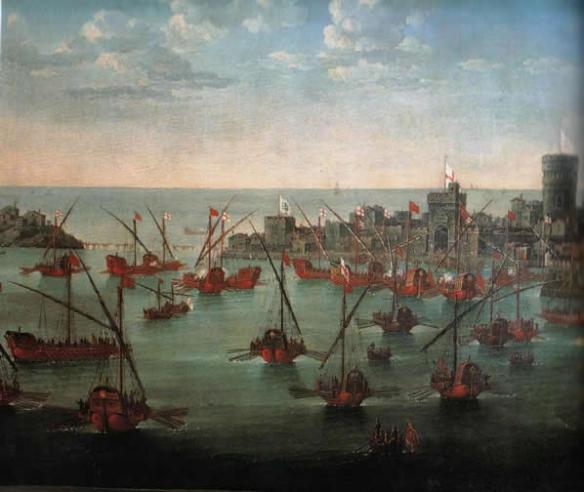War of Chioggia, (1378–1381)
Noble Venetian family, of which various sons served their republic as admirals and doges over several centuries. An early notable admiral was Tommaso Mocenigo (1343-1423). As a young officer under the great Venetian admiral Vettore Pisani, he fought during the losing 1379 campaign to drive Genoese forces under Andrea Doria from Pola; Pisani personally prevailed upon Mocenigo to bear news of the defeat back to Venice. Tommaso Mocenigo, as captain, together with Venetian admiral Carlo Zeno, fought successfully to break the Genoese blockade of Chioggia in 1381, and as admiral he led the Venetian fleet against the Turks during the Crusades, evacuating remnants of the retreating Christian army after their defeat at Nicopolis in 1396. He served as Venetian ambassador in Padua and Lombardy, as well as to the court of Hungarian King Sigismund. He was elected doge in 1414, replacing the strictly autocratic rule of his late predecessor, Michele Steno, with a balance of wisdom, serenity, and power. In 1416 came the welcome news that the Venetian fleet had routed the Turks at Gallipoli, after which Mocenigo made peace with the vanquished foe, later organizing a united front of Italian states in a campaign against Hungary.
Pietro Mocenigo
Pietro Mocenigo (1406-1476), one of the greatest Venetian admirals, is credited with restoring the Venetian navy after a period of decline. He began his naval training early and rose steadily through the ranks. By 1448 as a commander he was dispatched with Captain Paolo Loredan to Albania to propose an accord with Venice to Skanderbeg, who welcomed the alliance against the Turks. In 1470 Mocenigo performed the unhappy task of arresting fellow Venetian officer Nicolo Canale for the loss to the Turks of Negroponte (now Evvia; also Euboea) in the Aegean Islands. Negroponte had been a Venetian colony since the thirteenth century.
Mocenigo reorganized the Venetian fleet and for four years (1471-1474) waged nearly constant war against the Turks in the region, finally defeating them in Albania at Scutari (now Shkoder), where their attempted blockade was shattered. Returning to Venice after this long and successful campaign, Mocenigo’s fame catapulted him into the Doge’s Palace, where he sought until his death in 1476 to procure and ensure a lasting peace with the Turkish foe.
A later notable figure of this lineage was Lazzaro Mocenigo (1624-1657), whose rather brief career in the navy of Venice was nonetheless a succession of triumphs and valiant acts. In 1655, his ships routed the fleet of the Turkish commander, Mustapha, and in the battle Mocenigo lost an eye. Returning to the Dardanelles a year later, Mocenigo again defeated the Turks, and for this and other feats he was made Procurator of St. Mark, promoted, and given an equestrian award. On his third outing to the Dardanelles (1657), now as commander of the fleet, his ship’s magazine exploded, and a falling yard struck Mocenigo in the head, mortally wounding him.
Navy of Venice
Situated on islands in a lagoon at the northern extremity of the Adriatic Sea, the Republic of Venice depended upon sea power for prosperity and survival. Founded during the collapse of the Roman Empire, Venice retained ties with the Byzantine Empire and resisted incorporation into the medieval Germanic Holy Roman Empire.
In the age of the Crusades Venice battled both Muslim powers and Italian rivals. With its fleets Venice defeated the attempt of the Normans of the Two Sicilies to dominate the Byzantine Empire. Then in 1204 it diverted the Fourth Crusade to the conquest of Constantinople. Venice enjoyed a favored position in the eastern trade, which it generally maintained even after the Byzantines recovered Constantinople.
Detail of the Arsenal area. J. De Barbari, 1500, Venice, Museo civico Correr
The need for specialized war galleys caused Venice in 1104 to establish a government-run arsenal and develop Europe’s first regular navy. The patricians who dominated Venice willingly captained its galleys and fleets. To control the Adriatic and the sea routes to the east, Venice established strongholds on the Dalmatian coast, Corfu, and the Greek coast, and colonized Crete and several Aegean islands. In 1480 Venice acquired Cyprus.
Venice emerged victorious in its struggle with Genoa and Padua over the eastern trade in the War of Chioggia of 1379-1381, in which the Venetians mounted for the first time cannon on their galleys. Threats from Milan drove Venice to acquire a mainland empire that stretched from Padua to Bergamo. Piracy remained a perpetual problem.
Under a supreme Captain General of the Sea, Venice’s fleet was organized into squadrons for operations against Uskoks (Dalmatian pirates), patrol of the Adriatic and Ionian Seas from Corfu under the Captain of the Gulf, and defense of Crete and Cyprus. As many as 50 galleys might have been operational at any time. Extra hulls were mothballed in the arsenal, and for a major war 200 galleys might have become operational. While the elite volunteered to command, seamen and rowers came to be conscripted throughout the Venetian Empire, and marine infantry were hired from the Italian mainland or Germany.
